Twin Tacomas Conquer the Worst in Winter Test
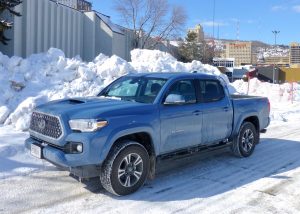
For a midsize truck, Toyota’s Tacoma is big enough for any job, except to see over a Duluth harborside snowpile.
By John Gilbert
We had an interesting coincidence at our home on the North Shore, just outside Duluth, Minn., in January. Our younger son, Jeff, recruited a friend to ride with him so he could drive his brand new Toyota Tacoma pickup truck from Bellingham, Wash., to visit us.
Such a trip in January of 2019 may not seem like a favorable time to be driving through the mountains and challenging Mother Nature in this never-ending winter, but for two young single guys it was an adventure.
His Tacoma is evidence of my long-held suspicion that full-size pickups have gotten bigger and bigger, and midsize pickups — such as the Tacoma — have grown just enough to fill in as perhaps the ideal size for anyone who thinks they need a full-size truck.
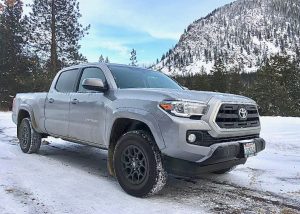
A road-test for real came when Jeff Gilbert drove his personal new truck from the Pacific Northwest to Duluth in January.
Toyota calls it a double cab, whereas you or I might think of it as a crew cab, because it has a full four-door cabin with plenty of room to seat three adults in the rear, and it is powered by a 3.5-liter V6. Jeff said they made good time, driving through Spokane, Coeur d’Alene, Idaho, then Billings and Butte in Montana, and on across North Dakota to Jamestown, Fargo, and on eastward on I-94 to Minneapolis, before heading to Duluth.
They had friends along the way and didn’t run into bad weather until finding the interstate closed and barricaded for drifting snow, necessitating an unscheduled motel stop in Jamestown.
The coincidental part of the story is that three days after Jeff left Minnesota to head home to Washington, my weekly test-drive vehicle arrived, and it was a 2019 Toyota Tacoma TRD Sport 4×4 Double Cab — almost identical to the truck Jeff recently bought from the Bellingham dealership where he works selling cars.
My wife, Joan, and I felt sad when Jeff departed — part of the job description of being parents — but a couple of things helped. For one, I recorded an audio CD for him of the late Guy Clark’s songs, off the “Best of the Dualtone Years” compilations after his death, underscoring Clark’s thought-provoking and clever writing and his outstanding guitar work. Jeff said he enjoyed it enough that he played through the entire double-album about three times before he got to Montana, and he had a lot of other music, too.
Our other idea was we made a deal with him to stay in hands-free phone contact from anywhere he was if he could use some conversation to pass the time, and keep us apprised of his adventure — flying solo, this time. By luck, he was trying to reach his friend’s place to spend his last night on the road in Coeur d’Alene when he got a phone call from a good friend from Bellingham, who had just happened to be on a brief trip to a favorite spot just east of Coeur d’Alene. When he called, Jeff was about an hour from arriving at the same town and his friend said he had already reserved a room for Jeff.
As luck would have it, the only really bad winter storm he encountered either way was coming out of the mountains and leaving Idaho to drive to Spokane. Freezing drizzle and a mountain storm whiteout made him glad he was driving in tandem with his friends as they drove the rest of the way to Bellingham, which is a scenic town about a half-hour from the Canadian border on the way to Vancouver.
We had our own winter-driving challenges around Duluth, and kept our hands firmly on the steering wheel of a 2019 Tacoma that just happened to arrive the day after Jeff left. The Tacoma breezed through the driving part with no flinching, switching its control switch from 2-wheel drive high for clear-pavement commuting, to 4WD automatic, where it could regulate its own selections of how much torque to apportion front and rear. I have to admit to yielding to the temptation of looking for some moderate plowed rows of snow to churn through.
It also was smooth on a trip to Minneapolis and back, for a 5-hour driving day, and the bucket seats and firmly planted stance of the Tacoma won our approval for being considerably more agile and maneuverable than the full-sized pickups of any brand.
Part of the attractiveness of the Tacoma was its exterior color, which was Cavalry Blue, a bright, medium blueish color unique amid all the countless colors available these days. The test Tacoma, being the TRD (for Toyota Racing Division) Sport model means it adds certain trim things, like the black alloy 17-inch wheels, and the sport-tuned suspension.
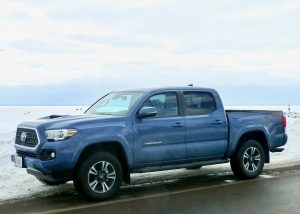
Ice fishermen put up portable fish houses on iced-over Lake Superior, but January was much cozier inside the Tacoma TRD.
Toyota has been revitalizing its engine line, and the Tacoma benefits from having the 3.5-liter V6 which has been recalibrated to deliver 278 horsepower at 6,000 RPMs and 275 foot-pounds of torque, which peaks at 4,800.
The base price of $36,465 climbs quickly to $42,825 with the addition of the TRD Premium Sport and Technology packages. The result is a Tacoma loaded with all the newest convenience and safety features, such as a towing receiver hitch, trailer sway control, sport-tuned shock absorbers, safety sense pre-collision device with pedestrian detection, lane-departure alert, automatic high beams, rear camera with cross-traffic warning, and a large navigation screen with sonar rear parking assist, a cleverly designed fold-down step for getting into the composite-coated bed, which has sliding cleats that can lock in place for tie-downs. That latter feature was first designed by Nissan, and it is one of those good ideas that every competitor tries and fails to beat. Toyota simply copies it. Smart.
The test Tacoma had the 5-foot bed, and a longer one is available, and, Jeff says, makes sense if you want to throw a trail bike in the back with your gear.
Fuel economy was under 20, but we spent a lot of time warming it up against sub-zero cold every day. The ride smoothness of the Tacoma is obviously attributable to the double-wishbone front suspension with coil springs, and the leaf-spring rear suspension with those sport-tuned shocks. The 4×4 capabilities are extracted via a 2-speed electronically controlled transfer case to engage the on-demand part-time 4-wheel drive.
An 8-speed automatic transmission shifts smoothly and gives the Tacoma a sporty feel to its acceleration. All part of the picture, and part of the “preview” test-drive we got from son Jeff’s long drive to visit.
Midsize pickups are making their strongest bid for prominence in years, with the General Motors Colorado and Canyon taking on a new challenger in the Ford Ranger, and we can only wait for Jeep and Hyundai to join Honda with less-than-full-size pickups. Meanwhile, the Toyota Tacoma, which is built in San Antonio, Texas, just keeps expanding its models and defending its claim of being the single vehicle with the best retained value — resale, to you and me — in the industry.


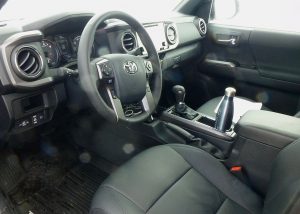
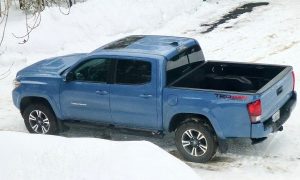
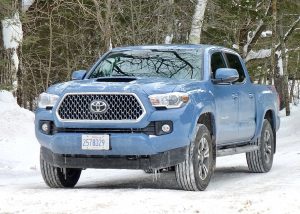
 John Gilbert is a lifetime Minnesotan and career journalist, specializing in cars and sports during and since spending 30 years at the Minneapolis Tribune, now the Star Tribune. More recently, he has continued translating the high-tech world of autos and sharing his passionate insights as a freelance writer/photographer/broadcaster. A member of the prestigious North American Car and Truck of the Year jury since 1993. John can be heard Monday-Friday from 9-11am on 610 KDAL(www.kdal610.com) on the "John Gilbert Show," and writes a column in the Duluth Reader.
John Gilbert is a lifetime Minnesotan and career journalist, specializing in cars and sports during and since spending 30 years at the Minneapolis Tribune, now the Star Tribune. More recently, he has continued translating the high-tech world of autos and sharing his passionate insights as a freelance writer/photographer/broadcaster. A member of the prestigious North American Car and Truck of the Year jury since 1993. John can be heard Monday-Friday from 9-11am on 610 KDAL(www.kdal610.com) on the "John Gilbert Show," and writes a column in the Duluth Reader.